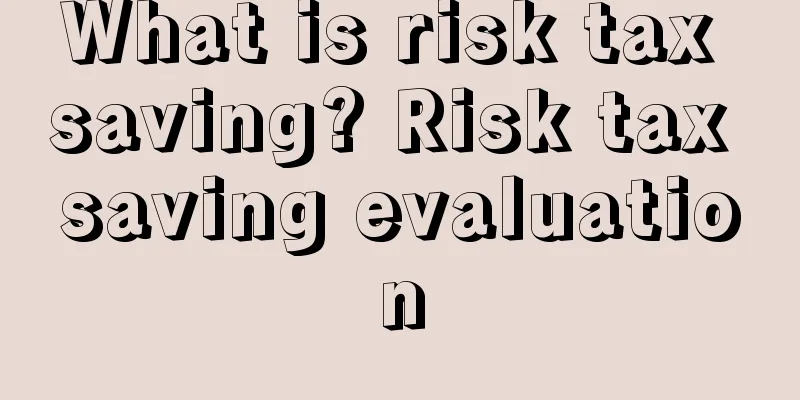What is risk tax saving? Risk tax saving evaluation

|
Risk Tax Saving Type Glossary Risk tax saving refers to reducing risk to the minimum in a certain period and under certain circumstances to obtain tax savings that exceed general tax savings. Risk tax saving mainly considers the risk value of tax saving. Classification Risk tax saving can be divided into two types: deterministic risk tax saving and uncertain risk tax saving. 1. Certainty of risk tax saving Some tax saving risks have certainty, such as tax incentives in different countries, tax rate differences in different countries, etc. In addition, changes in tax systems in different countries, economic cycles, market interest rates, inflation, the development of the enterprise itself and the range of changes in earnings have certainty. These deterministic risk factors must be taken into account when saving taxes, and can be taken into account as a quantitative factor. This kind of risk saving is called deterministic risk saving. In deterministic risk tax saving, we generally use probability theory to quantify risks based on past data and experience, and use the expected value calculation method to select tax saving plans. 2. Uncertainty risk tax savings Risks are somewhat uncertain. The deterministic risks mentioned above are only relative. In real life, many tax savings involve uncertain risks. For example, the exchange rate issue in international tax savings is highly uncertain. It is difficult for anyone to correctly predict the change in exchange rates. The tax savings from cross-border transactions may be completely offset or even increased due to the change in exchange rates. Therefore, the uncertainty risk factor must also be considered when saving taxes. We call this risk tax saving uncertainty risk tax saving. For the uncertainty factors of tax saving, the usual practice is to use subjective probability to calculate the risk level and risk value. First, the uncertainty factors are converted into certainty factors through subjective probability, and then quantitative analysis can be carried out. Subjective probability refers to the value of the probability of random events reasonably estimated by people based on limited information and experience in the absence of a large amount of historical data and actual experience. Since the degree of deviation between uncertain tax saving schemes and actual results is often greater than that of deterministic tax saving, in order to ensure the feasibility of tax saving, the degree of deviation of tax saving results from expected values, that is, the degree of risk, must be considered. We generally use standard deviation to reflect the degree of risk of uncertain tax saving: the larger the standard deviation, the greater the degree of risk. However, standard deviation is an absolute value and can only be used for tax saving schemes with the same expected tax value. For uncertain tax saving schemes with different expected tax values, the standard deviation rate should be used to reflect the degree of risk. Similarly, the larger the standard deviation rate of the tax saving scheme, the greater the degree of risk. |
<<: What is a Wish Trustworthy Store? Wish Trustworthy Store Review
>>: What is Zhiquancheng? Zhiquancheng Review
Recommend
What is Xinhua Logistics? Xinhua Logistics Review
Xinhua Logistics (Shenzhen Xinhua Logistics Co., L...
Anker's salary data was exposed, with 800 million yuan in bonuses spent in one year!
According to a survey, the cross-border e-commerce...
Amazon's page is making big changes again! Many adjustments and changes
Recently, Amazon has made a series of "secret...
Amazon Prime Day is coming, how to optimize FBA fees? You need to do this!
Amazon FBA is the first stop for most sellers to e...
EU accuses Amazon and eBay of not complying with safety laws! Prime Day may be postponed
TikTok downloads exceed 2 billion Social video ap...
The way you make products in a low-key manner is just like the Russians who dropped their supplies and ran away!
During China's current epidemic, the phrase &...
How to write Amazon instructions?
1. The first page is the cover, which is the brand...
FBA prices will rise across the board! Amazon delivery costs soared by 60%+!
Recently, an overseas data agency released a cost...
What is Dacor? Dacor Review
Dacor ( / ˈ d eɪ k ɔːr / "day-core") is ...
Urgent! If you don’t upload this type of file before November 9, your product will be removed from the shelves! A large number of sellers have been affected!
Yesterday, just as everyone was immersed in the jo...
A complete guide to creating a hit product on Amazon in 30 days
This issue's useful information A complete gu...
Need professional omni-channel off-site promotion and inventory clearance? Click here
The current service provider market is full of mix...
What is Tianyun International Logistics? Tianyun International Logistics Review
Tianyun International Logistics (Group) Co., Ltd. ...
The latest US retailer sales rankings for 2024
It is learned that recently, the National Retail F...
Trump gave money! Sellers received a huge order, and sales soared by 700,000%! The secrets of the hot-selling products abroad are revealed!
Since the outbreak of the epidemic, coupled with a...









